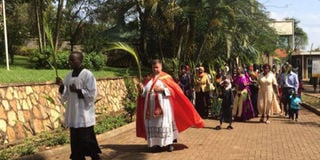Prime
Young Catholics causing rebirth of Tridentine Mass

The faithful participate in a walk on Palm Sunday ahead of Easter. BELOW. Fr Christophe Nouveau leading the faithful in a traditional Latin Mass in Kisenyi, Kampala. COUTESY PHOTO
Every Sunday morning, a special congregation of Catholics meets at the Uganda Catholic Management and Training Institute at Rubaga Cathedral, Kampala to celebrate the Tridentine Mass (traditional Latin Mass).
This Mass, comprised of mostly young people, started three years ago when a priest who could lead it became available.
Fr Christophe Nouveau is one of a kind in the country. “I was first contacted by some parishioners of Rubaga in late 2004 when I had just moved to Kenya. I had been invited there to start a traditional Latin Mass congregation and a few months into the mission, Uganda came calling,” he says.
The 46-year-old priest could only commit to one country at a time, and therefore could only visit the Rubaga parishioners once in a while for the next ten years. He moved to Uganda in 2015.
The year 2015 was the first time that the traditional Latin Mass was celebrated in Uganda in 46 years. Worldwide, in 1969, the Mass of Paul VI (New/Ordinary Mass) was introduced in the Catholic Church.
Up until 1969, the traditional Latin Mass had been in use for 90 years in Uganda. The White Fathers used the traditional Latin Mass to win the hearts of their first converts, the young men who later become the Uganda Martyrs.
Worldwide, this is the Mass that people such as, St. Gregory the Great, St. Thomas Aquinas, St. Louis IX, St. Philip Neri, Blessed Miguel Pro, Blessed John Henry Newman, St. Edith Stein, St. Padre Pion and St. Josemaría Escrivá said every day.
What is traditional Latin Mass?
Traditional Latin Mass is not just a Catholic Mass in Latin. It is an elaborate way of worship, conducted in Latin, where utmost reverence and veneration is showered on the altar because it is strongly held that Christ is physically present, sacrificing himself on the altar for the remission of sins.
The Holy Eucharist takes absolute center stage because it is believed, Jesus Christ is offering himself in literal terms. So central is the altar of the Eucharist to this liturgical rite that the priest faces the altar, with his back to the congregation as opposed to the New Mass where the priest faces the congregation.
The priest leads a congregation on a solemn journey to the altar of the sacrifice of Jesus Christ. That explains why the garments of the priest are more elaborately decorated at the back.
The priest only turns to the congregation a few times such as, when it is time to give the Holy Eucharist and to read the gospel and announcements – these are read in a non-Latin language.
The use of musical instruments is not accepted, nor are acts such as, clapping, dancing or ululating because they are believed to take the mind of the congregation away from what matters. It is an extremely solemn atmosphere.
Though most dioceses in Europe and the Americas never stopped celebrating the traditional Latin Mass, the promulgation of the New Mass brought an end to the traditional Latin Mass across Africa.
Revival of traditional Latin Mass
In 2007, Pope Benedict XVI issued the motu proprio Summorum Pontificum and wrote to every Catholic Bishop in the world, authorising the use of the Tridentine Mass by all Latin Rite Catholic priests in Masses celebrated without people.
The pope further urged that the Masses may be attended by the faithful who ask to be admitted at their own free will. He stated that the 1962 edition of the Tridentine Mass is to be considered an extraordinary form of the Roman Rite.
Today, many young people are rediscovering the Latin Mass all across the world because of the internet.
An article in USA Today stated, “There is a movement among young Catholics to know, discover and preserve their Catholic heritage, and the traditional Latin Mass fits in with that. I think they are drawn to the liturgical richness of the past,” said Joseph Kramer, a Rome-based priest who has long advocated for the re-introduction of the Latin Mass.
Fr Nouveau has also been contacted by Catholics in Tanzania, Rwanda and Burundi. He regularly travels to parishes in Mbale, Soroti, Kabale districts to lead the Latin Mass.
Why this Mass is important
The traditional Latin Mass presents a great sense of beauty and reverence and a sense of historical continuity. A sense of awe fills your heart to know that when you come to the Latin Mass you are praying the same prayers that the saints from as far back as 1,500 years ago prayed including our very own Uganda Martyrs.”
So far, two young men have already been sent to a special seminary in France to gain expertise in leading the traditional Latin Mass and two more will leave this year for the same.
Who knows, may be in the next 20 years, a good number of Catholic parishes in the country will be holding at least one Latin Mass every Sunday Morning. The yearning is definitely there today.




